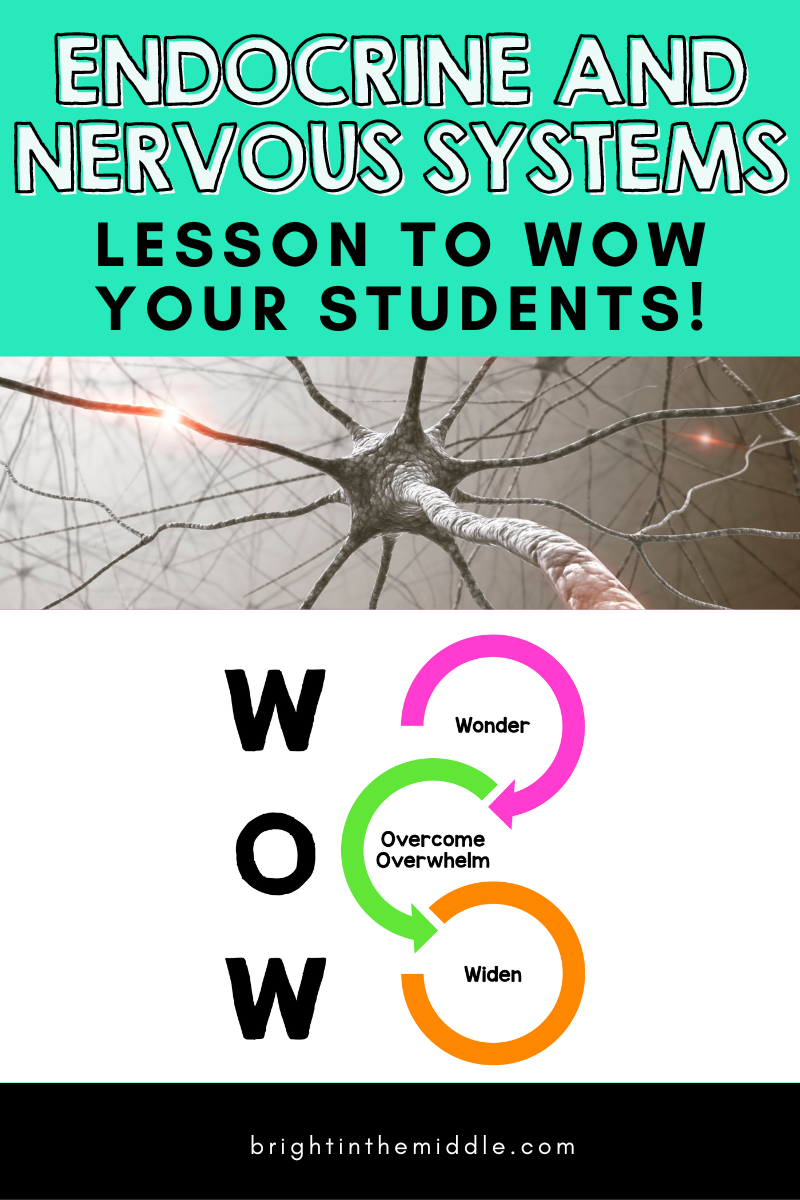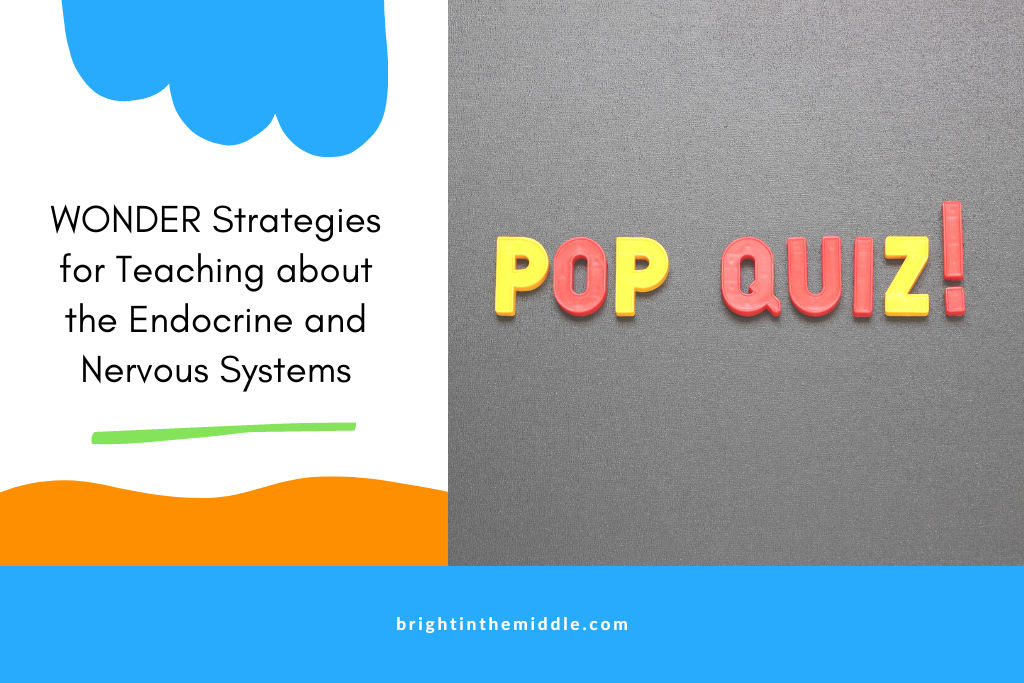Teaching about the body systems and want to spend some time focusing on the endocrine and nervous system relationship? I have some great ideas for you to show how these systems work together as well as work with other body systems. That’s the main focus in middle school, how all of these systems work together, but it doesn’t hurt to dive a little deeper.
So, how are the endocrine and nervous systems connected? First of all, they work together to maintain homeostasis and both of them respond to stimuli.
The nervous system works more rapidly and provides a short-term response, whereas the endocrine system works more slowly and has more of a longer-term response by releasing hormones.
Also, the nervous system can directly impact hormone release by the endocrine system!
In this post, I will share how you can explain the endocrine and nervous systems to your middle school students using the WOW Factor.
First, I will share some ideas to get your students excited about learning about these systems. Second, I will share an interactive lesson that dives into more details about these systems. Finally, I will share some widen activities to give students a chance to learn even more about the endocrine and nervous system relationship and the systems as “separate body systems”.

WONDER Activities to Explore How the Endocrine and Nervous System Work Together
As all of my posts describe, it’s important to get your students excited about learning each topic. They have this middle school student syndrome where learning is “not as cool”, so you kind of have to win them over. I call these WONDER strategies. These strategies help students get internally motived to learn.
Below, I have two wonder strategies that you can use with your students to make them wonder about both the endocrine system and the nervous system and how they are related.
You can choose to do one or both!
Surprise Skit
One thing that you can do to get students wondering about these systems is to have them to create a quick skit.
You can choose volunteers to come up with a skit or you can put your students in groups to give everyone a chance to participate!
So, what is this skit about? Students should create a skit to show their response to some type of external stimuli that is a surprise such as a boom of random thunder that scares them or the shock of the teacher giving a random pop quiz that they were not expecting.
Here are some guidelines:
- Create a 3 minute skit to show your response to a surprise.
- Be sure to show and explain how your body reacts.
- Be creative!
At the end of the skits, whether it be one or the whole class, have a discussion about how the body reacted to these situations and you can go ahead and discuss some vocabulary if your students did not explain these in their skits.
When your body goes into “fight or flight” mode, your endocrine and nervous systems jump into action.
Your nervous system sends a message to your endocrine system to release certain hormones.
The amygdala and the hypothalamus (of the brain) send signals to the adrenal glands (of the endocrine system) to pump the hormone epinephrine to the bloodstream.
Things start to happen. The heart starts to beat faster, blood pressure goes up, breathing rate increases, sight becomes shaper, pupils are dilated, skin becomes flushed, and more.
This is a natural response from our system.
At this point, students may want to learn even more about these systems and the amazing things they do for us!
They will learn more about the endocrine and nervous system relationship

Systems – Telephone Game
Another thing that you can do is to play a version of the classic game of telephone to represent the response of the nervous system and the endocrine system to compare them.
- Split your class into two groups and have them line up for a game of telephone.
- One group will represent the nervous system, and the other group will represent the endocrine system.
- For the nervous system group, tell them that they are going to play the game as fast as the can. Tell the first person one word to spread, such as “breathe” and have tell them to go as fast as they can. This will represent the quick and short-term response from the nervous system.
- For the endocrine system group, tell them a phrase like, “fight-or-flight” and tell them to go a little slower, waiting about 5 seconds between each person. This will represent the longer-term response from the endocrine system.
After the game, explain that although there were two groups in this game, don’t completely look at the systems as separate entities, but as a puzzle that works together. There is a endocrine and nervous system relationship. Each section of the puzzle may have a different job and look a little different, but they ultimately work together to make a beautiful masterpiece!
Endocrine System and Nervous System Relationship Interactive Lesson
Are your students excited yet? They should be. They just had great time doing the wonder strategies, right?
Now, it’s time to get into the vocabulary and talk about the parts of these systems with the focus remaining on the relationship between the endocrine and the nervous system.
An interactive lesson is the perfect addition to your lesson plan to learn about the content! Interactive lessons were specifically designed to teach the content in a way that is broken into digestible chunks to make the lesson more understandable and engaging for students.
It helps to reduce cognitive load to help students to better retain the information! Isn’t that the goal?!

This particular endocrine system and nervous system interactive lesson is no exception! How do the nervous and endocrine systems interact? Students will learn about how these systems work together, the structures and functions of both the nervous system and endocrine system, the glands of the endocrine system, the brain, spinal cord, and nerves, neurons, the central and peripheral nervous system, the sympathetic and parasympathetic nervous system, and more!
Within the lesson, there are interactive activities for students to pause and process the information. These include a KWL, text box questions, a Venn diagram, four corners vocabulary, drag-and-drop activities, and more! It’s the perfect lesson to focus on the endocrine and nervous system relationship
This lesson can be found in the Bright in the Middle Shop.
It can also be found on TPT.
Widen Activities for the Nervous System and Endocrine System
There are standards to meet for most states, and for middle school body systems, you don’t have to go into as much detail as you would a high school Biology class; however, it doesn’t hurt to widen student knowledge to help prepare them. You should definitely try a widen strategy after the lesson.
These help students learn more and also show off what they already have learned!
Endocrine and Nervous System Disease Research
As essential as it is for students to know how their body systems work and work together. It’s also important that they know about what happens if things don’t work as the textbooks say they do.
To widen their knowledge, students can research and present about a disease or disorder related to these systems. Some students may be passionate about a certain disease because they may know someone that has it, or they may have it themselves.
You can have students research what the disorder is, what the symptoms are, the causes, and if there is any treatment.
Students can present about their disorders in any way you (or they) choose. They can create a presentation, a brochure, a video, or any other way to present information.
Here is a list of diseases and disorders they can research.
- Endocrine System Diseases and Disorders
- Diabetes
- Hyperthyroidism
- Addison’s disease
- Cushing’s disease
- Gigantism
- Thyroid Cancer
- Nervous System Diseases and Disorders
- Spinal Cord Injuries
- Alzheimer’s disease
- Huntington’s disease
- Multiple sclerosis
- Epilepsy
- Amyotrophic lateral sclerosis
Brain Model
Students love to learn about the brain. It is so amazing and mysterious!
One of the things that students can do to widen their knowledge is to create a brain model. Your brain controls everything and is connected to ALL body systems. What better way to talk about how all the body systems work together than to learn more about the brain.
Task your students to create a model of the brain. You can have them go all out and just give them some materials and say GO…or you can look at some of these options I found online.
Help your students master science content!



[…] Endocrine and Nervous Systems […]